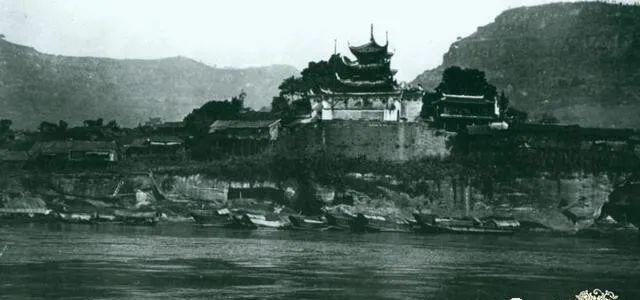
Yunyang Zhangfei Temple, built in the late Shu Han Dynasty, has been repaired since then, more than 1700 years ago. According to legend, after Zhang Fei was assassinated by the generals Fan Jiang and Zhang Da, his head was cut off by him to offer to Eastern Wu, but halfway to hear Wu Shu's peace, the two threw their heads into the river, just happened to be salvaged ashore by a fisherman, so the people buried him at the foot of Feifeng Mountain and built a temple to commemorate it.
Chongqing Chaotianmen Wharf. Chaotianmen Wharf is located at the confluence of the Yangtze and Jialing rivers and is the largest water wharf in Chongqing. In the picture, it can be seen that there were many stilt towers on the dock at that time, which was one of the most prosperous places in Chongqing at that time. To this day, Chaotianmen Wharf is still very lively and bustling.
The ghost town of Fengdu, this photo was taken in 1908, the left side of the picture is the poppy planted by the locals, because in the Qing Dynasty, opium smoking was more prevalent, and the price of opium was more expensive, so many people planted themselves, so that they could not only smoke themselves but also sell money.
Chongqing Wanzhou Ancient Bridge. The bridge was built in 1870, the two ends of the bridge are stone steps, so it is only for the people to walk, there are six houses on the bridge, very simple and beautiful. Unfortunately, the bridge was washed away by floods in 1970.
Chongqing Futuguan Arch, this photo was taken in 1892. Futuguan is the western gate of Chongqing, which is surrounded by water on both sides and cliffs on three sides, and in ancient times it was a place where soldiers and families had to fight. The Tang Dynasty poet Li Shangyin's sentence "Bashan Night Rain Rises autumn pond" is written here.
Wenfeng Pagoda in Chongqing at the end of the Qing Dynasty. Wenfeng Pagoda was built in the ninth year of Jiaqing, is a stone and wood structure of the tower, a total of nine floors, the tower height of 33 meters, is very majestic. However, it was destroyed in the 1960s, and today's Wenfeng Pagoda is restored.
Juelin Temple in Chongqing at the end of the Qing Dynasty. Juelin Temple was built during the Southern Song Dynasty, destroyed in the late Ming Dynasty due to war, and rebuilt during the Kangxi Dynasty. In the 1930s and 1940s, kyaw Rinji Temple had no monks, but was used as a factory, and the Buddha statues inside were destroyed until the 1980s.
This photo is Shibaozhai in Minchuzhong County at the end of the Qing Dynasty, which is known as the "Pearl on the River". The boulder in front of the picture is said to be a gem left over from the time when the female snail patched up the sky, and it is also known as "Jade Seal Mountain" because of its shape like a print. At the end of the Ming Dynasty, Tan Hong rebelled, he called himself "King of Wuling", and installed a village here, hence the name "Jewel Village".
The city wall of Chongqing at the end of the Qing Dynasty. Chongqing has experienced three large-scale construction of city walls in history, the earliest being the Qin Dynasty Zhang Yi building the city wall, the second time being the Southern Song Dynasty in order to resist the Mongols, Peng Daya built the city wall, the third time was the Ming Dynasty Hongwu years, built a total of nine open and eight closed a total of seventeen city gates, but now only two remain.
Source: Happy Entertainment Penguin
Disclaimer: This article is reproduced for the purpose of transmitting more information. If there is a source labeling error or infringement of your legitimate rights and interests, please contact us, we will correct and delete it in time, thank you.
The copyright belongs to the original author, if there is any infringement, please contact us to delete!